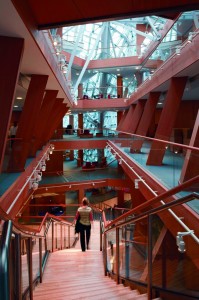When asked to envision a modern biotechnology laboratory, lay persons might describe what they’ve seen on an episode of CSI: Miami. Gleaming glass and striking colored lights might look good on television, but they are not what biological researchers need to do their work most effectively. Most of the real biological laboratories I’ve visited, in fact, have been stark, white, fluorescent-lit environments that more resemble something out of 2001: A Space Odyssey. But those are becoming passé. The newest concepts incorporate natural lighting and expansive interiors to encourage collaboration and creativity. And technologies such as robotic automation and single-use systems are as much of an influence as the needs for cost containment and environmental sustainability.
Technology has always driven laboratory design, of course, from the darkness of 19th-century research before electricity to the fluorescent lighting so familiar to scientists and office workers of the 20th century. Biological research has also evolved from hands-on wet chemistry using elaborate glassware and manual techniques toward increasingly sophisticated instrumentation and plastic labware.
Flexibility and Sustainability
“Today’s modern lab designs must do more, do it better, and do it smarter,” wrote Labconco product manager Kelly Williams in a December 2013 blog posting (1). She pointed out that the 2008 recession had an impact on approaches to laboratory design by making companies and other research organizations more budget conscious. As construction resurged after the downturn, the focus was on flexibility and operational efficiency (2). Flexibility can be achieved through use of modular laboratory furnishings and building designs that include serviceable ceilings and open, “ballroom” style floorplans. And environmental sustainability is no longer an afterthought.
LEED certification doesn’t just give a facility “green cred.” It can lead to savings in utility and operation costs, too. The Fabrikstraße 15 building Novartis (right) built in 2009 on its Basel, Switzerland, campus is a good example. Designed by architect Frank Gehry, the modern glass-and-steel design features an energy-efficient façade that has 85% of its roof surface covered with photovoltaic cells contributing 92 kWp of power. LED and natural lighting cut down on the total power requirements, as does an architectural approach using natural complements to the heating, ventilation, and air conditioning (HVAC) systems.
technology Biotechnology laboratory design has always been characterized by extreme functionality. Results produced in life- science laboratories must be reproducible and verifiable in different locations. So modern laboratory design is subject to certain standards and norms, from good laboratory practices (GLPs) for bioresearch to good manufacturing practices (GMPs) for quality and development laboratories supporting the manufacture of human medical products. As advancing analytical and other technologies change over time, the norms must adjust. New instruments arrive as old ones go obsolete — and the new ones are often smaller with integrated data and control systems. Information technology in general has an increasing presence: Many laboratories include office space within them. Automation is helping some scientists make better use of their time and expertise (3, 4). As a result, bioscience laboratories must accommodate liquid handling and sample storage systems.
Meanwhile, many of the same sorts of disposable systems and components that are making a big difference on the manufacturing floor have shown up in development laboratories too. In fact, it is at smaller scales that single-use technologies found their earliest utility (e.g., in cell-line development, validation studies, and so on). For example, autoclavable glass bioreactors have — like much laboratory glassware — been replaced by plastic alternatives.
Safety and Collaboration
Designing modern laboratory facilities involves careful consideration of critical elements such as temperature and humidity control, air pressurization, sound and vibration, contamination control, ventilation, air quality, worker safety, and energy conservation. Biosafety cabinets and other isolator technologies contribute to flexibility as well. And workplace ergonomics come into play because repetitive stress is an increasing concern.
Finally, science has evolved over the past century into less of an individualistic endeavor and more of a “team sport.” As office workers leave their cubicles behind, so too do open laboratory spaces make collaboration easier and more likely to happen. Spontaneous “Eureka!” moments are now much more likely to arise in cross-discipline conversations than in a quiet personal laboratory on a dark and stormy night.
References
1 Williams K. Recession Left Lasting Changes in Laboratory Design. Labconco Science News 17 December 2013; www.labconco.com/news/recession- left-lasting-changes-in-laboratory-des.
2 Hock L. Modern Lab Design’s Slow Resurgence, Sustainable Edge. Lab. Design News 15 October 2013; www.labdesignnews.com/ articles/2013/10/modern-lab-designs-slowresurgence-sustainable-edge.
3 Wells G. In the Laboratory Automation Zone: From Test Tube to Microarray —Smaller, Faster, and (Maybe) Cheaper. BioProcess Int. 6(4) 2008: 56–58; www.bioprocessintl.com/analytical/product-characterization/in-the- laboratory-automation-zone-183968.
4 Wing AK. Laboratory Automation and Optimization: The Role of Architecture. Clin. Chem. 46(5) 2000: 784–791.
For Further Reading
Brotman JM, Skolozdra R. AIA: Laboratory Design, Building for Breakthrough Science. Building Design Construct. 9 December 2012; www. bdcnetwork.com/aia-laboratory-design-building-breakthrough-science.
Harris W. Beyond the Bench: Meet the Modern Laboratory Facility. Building Design Construct. 9 October 2014; www.bdcnetwork.com/blog/ beyond-bench-meet-modern-laboratory-facility.
Hock L. The Ups and Downs of Modern Laboratory Design. Lab. Design News 15 June 2012; www.rdmag.com/articles/2012/06/ups-and- downs-modern-laboratory-design.
Hock L. Trends in Modern Lab Design. Lab. Design News 6 June 2014; www.labdesignnews.com/articles/2014/06/trends-modern-lab-design.
Roberson J, et al. Constructing a Modern Cytology Laboratory: A Toolkit for Planning and Design. Cytojournal. 10(3) 2013.
Scott C. Sustainability in Bioprocessing: Not Just an Afterthought. BioProcess Int. 9(10) 2011: 25–36; www.bioprocessintl.com/manufacturing/ antibody-non-antibody/sustainability-in-bioprocessing-323438.
Seiffert D. The Modern Laboratory: It Looks More Like an Office. Boston Business J. 16 January 2014; www.bizjournals.com/boston/blog/ bioflash/2014/01/the-modern-labratory-it-looks-a-lot.html.
Skolozdra RB. It’s All in the Planning. Lab Manager 10 December 2012; www.ourdigitalmags.com/display_article.php?id=1248626.
Springer S. Laboratory Design for the Future. LaboratoryNews 16 April 2007; www.labnews.co.uk/features/laboratory-design-for-the-future.
Watch D. Trends in Lab Design. Whole Building Design Guide 19 September 2012; www.wbdg.org/resources/labtrends.php.
Cheryl Scott is cofounder and senior technical editor of BioProcess International; cscott@bioprocessintl.com.

